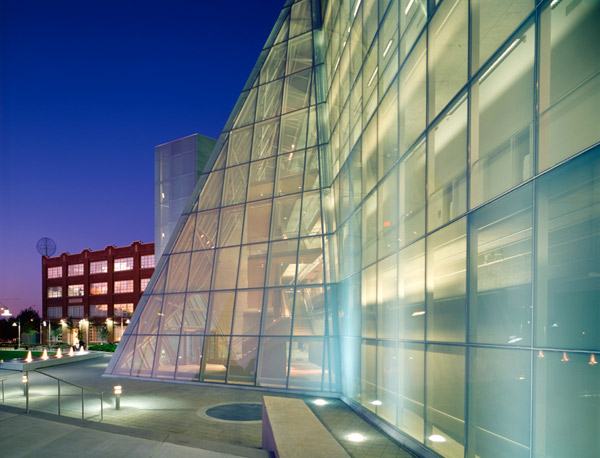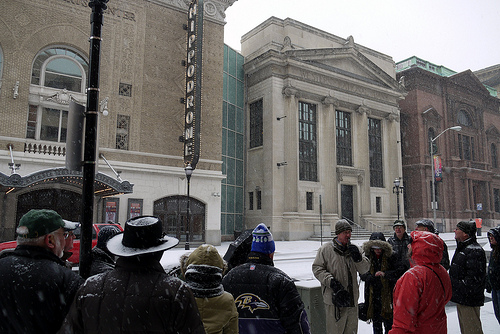Read’s drugstore flap brings Baltimore civil rights history to life, The Baltimore Sun, February 8, 2011
Author: Johns
Johns Hopkins has been the executive director of Baltimore Heritage since 2003. Before that, Johns worked for the Maryland Department of Housing and Community Development developing and implementing smart growth and neighborhood revitalization programs. Johns holds degrees from Yale University, George Washington University Law School, and the University of Michigan’s School of Natural Resources and Environment.
Behind the Scenes Tour of MICA’s Brown Center
New buildings in historic districts don’t have to be bland or drag down the historic and aesthetic character of the area. The Brown Center at the Maryland Institute College of Art offers a striking example of where first-class modern architecture can add a bold new design while bringing out the best in existing historic buildings. Please join us on a tour of the Brown Center to explore this modern architectural landmark and its relation to MICA’s historic campus.
MICA’s Brown Center | 1301 Mt. Royal Avenue, Baltimore, MD 21217
Thursday, February 10, 5:30 PM to 6:30 PM
$10 for members; $20 for non-members
Register today!
Join us for a second West Side Walking Tour on January 20!

We’re returning to the Superblock this week for a second lunchtime walking tour on why historic buildings matter to the future of a revitalized West Side and how the proposal for the Superblock threatens to demolish that future. The tour takes place on the 50th Anniversary of the 1955 sit-in at the Read’s Drug Store at Howard & Lexington Streets, so we’ll be sharing a few stories about how black and white civil rights advocates fought to provide African Americans with equal rights to shop, work, and eat on Downtown’s West Side. From the Afro American’s Orchid & Onion 1945 campaign against downtown stores that discriminated against African American customers (“Onions” discriminated against black shoppers and “Orchids” did not) to the 1955 sit-in by the Baltimore Committee on Racial Equality and the students and faculty of Morgan State, Baltimore’s Civil Rights heritage can be found throughout the historic buildings of Downtown’s West Side.
West Side Lunchtime Walking Tour | East Entrance to Lexington Market (Lexington & Eutaw Streets)
- Thursday, January 20, 2010
- 12:15 pm to 1:00 pm
- Free tour, RSVP Today!
Please also join us on February 9 from 7:00 to 8:30 PM at the Reginald F. Lewis Museum for a public forum on Preserving Baltimore’s Civil Rights Heritage. We’ll begin the forum with short presentations by Dr. Helena Hicks, a participant in the 1955 Reads Drug Store sit-in, Dr. Gabriel Tenabe on restoring the home of long-time Baltimore NAACP President Lillie Mae Carroll Jackson, Ms. Tanya Bowers from the National Trust for Historic Preservation on the proposed National Civil Rights Heritage Trail, and more. We’ll follow the presentations with an opportunity for attendees to share their own questions and comments on how we can preserve the stories, buildings and neighborhoods tied to Baltimore’s long civil rights fight. Stay tuned for further details on our February 9 program!
Behind the Scenes Tour of Baltimore City College
We all know the “Castle on the Hill.” Many of us spent a good part of our young lives there. Now please join us in walking through and learning the quintessential Baltimore history of this much beloved city landmark. And, yes, Poly grads are welcome too!
Baltimore City College | 3220 The Alameda, Baltimore, MD 21218
- Wednesday, January 19, 2011, 5:30 p.m. to 6:30 p.m.
- Park in the school lot that is accessed from The Alameda
- Register online today! $10 for members; $20 for non-members (please join!)
Moving forward from ten years of work on the historic West Side
A panel from the Urban Land Institute that Mayor Stephanie Rawlings-Blake engaged around the redevelopment of downtown’s “West Side” recently delivered preliminary recommendations (more from the Baltimore Sun). As the area continues to be in the spotlight and we continue working towards a renewed and revitalized West Side, we thought it would be helpful to provide a short recap of how redevelopment plans that have evolved from early proposals calling for widespread demolition to current plans based on both preservation and redevelopment.
The “West Side” of Baltimore’s downtown is an area roughly bounded by Pratt Street (south), Read Street (north), Martin Luther King, Jr. Boulevard (west), and Liberty Street/Charles Center (east). From the late 1700s through the 1940s, the West Side grew as a vital center of transportation, commerce, and cultural life. This growth first began with Lexington Market in 1782–a place that inspired Ralph Waldo Emerson to declare Baltimore the “Gastronomical Center of the Universe”– and continued in the early 20th century with the construction of dozens of premiere department stores and movie theaters that many Baltimoreans still remember fondly. Unfortunately, in the late 20th century retail shopping and investment drifted out to Baltimore’s suburbs, many of these businesses closed, and their buildings began to decay from neglect.
View West Side’s Market Center Historic District in a larger map
After years of decline, Baltimore City proposed a plan in the 1990s that took an old-fashioned urban renewal approach to redevelopment and threatened to demolish 150 or more historic buildings (See Baltimore City Council Ordinance 98-333, 1998). In response, Baltimore Heritage and our partner Preservation Maryland developed a preservation based strategy for the revitalization of the West Side (PDF). This strategy proposed focusing new construction on existing vacant lots, rehabbing existing buildings for new uses, and reducing the number of historic buildings slated for demolition. In 1999, the National Trust for Historic Preservation listed Baltimore’s West Side on its annual list of 11 Most Endangered Historic Places in recognition of the threat to one of the best collections of historic buildings in any downtown. In 2000, the National Register of Historic Places listed the West Side as the Market Center Historic District designating hundreds of West Side buildings as significant historic structures.
In 2001 with strong encouragement state legislature, Baltimore City adopted a new preservation-based strategic plan (PDF) and signed an agreement with the Maryland Historical Trust laying out a process for preserving historic buildings and moving forward with revitalization. Many of us celebrated the agreement, which has been in effect in the decade since and continues to guide development today. This agreements supported the rejuvenation of nearly 50 historic buildings, including the rehab of the former Stewart’s Department Store as Catholic Relief Services, the Hippodrome Theatre’s transformation into the France-Merrick Performing Arts Center, and the reuse of a handsome retail block on Franklin Street as St. James Place. These projects and many more reflect hundreds of millions of dollars in public and private investment with substantial support from state and federal historic tax credits. However, the real challenge is that redevelopment has taken much longer than envisioned and much of the area, including the Superblock along Lexington Street east of Lexington Market and the Howard Street corridor, is still characterized by vacant buildings and limited street life.
Most recently, Mayor Rawlings-Blake convened a panel from the Urban Land Institute to provide recommendations to jump-start a new phase of revitalization on the West Side. The ULI panel provided preliminary recommendations on December 10, 2010 and final written recommendations from the ULI panel are due to the Mayor in the spring. In one of their most important points, the panel highlighted the West Side’s historic buildings as the area’s greatest asset. Baltimore Heritage is dedicated to supporting a process that can reestablish the West Side as a great Baltimore neighborhood with a distinctive historic character and thriving street life that can attract residents and businesses from across the city and the nation. Our series continues next week with a discussion on the “Superblock” and how historic Lexington Street–formerly known as the heart of downtown–is at the center of this effort to preserve and revitalize the West Side as a great place for Baltimore.




